Key Takeaways
The global music streaming market is valued at USD 47.06 billion in 2025, and Apple Music holds 20% of the revenue in this market.
Essential features include user profiles, music libraries, smart search, AI suggestions, custom playlists, offline mode, and in-app payment.
Steps to build an app like Apple Music includes market research, defining features, choosing tech stack, designing UI/UX, testing, launching, and maintenance.
Development costs range from USD 80,000 for MVPs to USD 260,000+ for advanced apps, as budgets vary by features and desired scalability.
Monetization models include subscription, in-app purchases, affiliate sales, partnerships, exclusive content, and the selling of app activity data.
Leading future music app trends are AI-driven personalization, AR/VR experiences, blockchain integration, and high-fidelity/interactive audio.
JPLoft provides end-to-end development solutions and support, helping both startups and businesses with tailored apps like Apple Music.
Knowing how to create an app like Apple Music is an ambitious but highly rewarding project that involves various aspects of development, design, and business strategy. With the increasing demand for music streaming services, building an app similar to Apple Music can unlock vast opportunities in the digital music landscape.
However, to develop an app like Apple Music requires more than just streaming capabilities. From ensuring the smooth integration of music libraries and creating personalized recommendations to providing a seamless user interface and an engaging experience, the development process is diverse.
In this blog, we will guide you step-by-step on how to create a music streaming app that rivals industry giants like Apple Music. Whether you are a startup or an experienced entrepreneur looking to break into the music tech space, this guide will provide you with the key insights and essential steps to get started on your app development journey.
Let’s dive in!
What is Apple Music & Its Market Stats?
Apple Music, launched in 2015, is Apple’s premium music streaming service that has grown into one of the world’s leading platforms for music lovers. It offers an extensive catalog of over 100 million songs. Curated playlists, exclusive releases, and personalized recommendations powered by advanced algorithms.
Unlike its competitors, Apple Music integrates deeply with the Apple ecosystem, ensuring seamless use across iPhones, iPads, Macs, Apple Watches, and even HomePods. This tight integration enhances user experience and drives customer loyalty. It also appeals to audiophiles with lossless audio, spatial audio with Dolby Atmos, and high-resolution streaming options that set it apart in sound quality.
Furthermore, the service continuously evolves with features like real-time lyrics, offline downloads, and live radio stations such as Apple Music 1. Its partnerships with artists for exclusive content, early releases, and curated mixes strengthen its cultural relevance.
Apple Music and Related Market Stats
The global music streaming sector is experiencing rapid growth and is expected to see a rise in the number of users and revenue through the next decade. To gain a better understanding of Apple Music's dominance in the music market, consider the following statistics:
-
As estimated by GlobeNewsWire, the global music streaming market is valued at USD 47.06 billion in 2025, with projections of reaching USD 143.89 billion by 2032, expanding at a 17.3% CAGR.
-
According to Hypebot, the total number of global subscribers to Apple Music ranges between 93 million and 124 million, and about 45.9 million subscribers in the US alone.
-
Soundwave estimates that Apple Music has a global market share of 20% of the streaming market, trailing only Spotify (~ 35%), with around 31% share in the US.
-
Apple Music's global revenue in 2024 was about USD 9.2 billion, making up 6.4% of Apple’s total services income, as estimated by Hypebot.
-
In research by Statista, the global user penetration was about 13.3% in 2025 and is expected to rise to 14.7% by 2030.
Today, Apple Music is not just a streaming platform, it is a personalized music hub that combines technology, creativity, and premium audio quality to deliver an unmatched listening experience worldwide.
Now that we’ve explored what Apple Music is and examined its place in the market, let’s shift gears to understand how to build an app like Apple Music and how it works.
How Does the Apple Music App Work?
Apple Music is a sophisticated music app that offers a seamless experience for music streaming, discovery, and playback. Apple Music is developed to deliver a smooth and personalized music streaming experience through a series of simple but powerful steps:
Step 1: Sign Up and Subscription
Users begin by signing up with their Apple ID. Apple Music offers individual, family, and student plans. A free trial is usually available, after which the subscription unlocks full access to the platform’s vast catalog.
Step 2: Music Library Access
Once subscribed, users can explore Apple Music’s 100+ million tracks, curated playlists, and albums. The app allows seamless browsing by genre, mood, top charts, or curated recommendations. Users can also add tracks to their personal libraries or create custom playlists.
Step 3: Personalized Recommendations
Apple music like app development employs advanced algorithms combined with human curation to deliver personalized suggestions. Based on listening history, liked songs, and followed artists, the app curates playlists such as “Made for You,” “New Music Mix,” and “Favorites Mix.”
Step 4: Streaming and Downloads
Users can stream music instantly with high-quality audio, including options like lossless and spatial audio with Dolby Atmos. Additionally, songs can be downloaded for offline listening, ensuring access without internet connectivity.
Step 5: Real-Time Features
Apple Music enhances engagement with real-time lyrics that sync with playback. The app also includes social features, letting users follow friends, share playlists, and see what others are listening to.
Step 6: Exclusive Content and Radio
The app features exclusive artist releases, live performances, and Apple Music 1 with its 24/7 global radio station hosted by popular DJs and artists. This keeps the service culturally relevant and dynamic.
Step 7: Cross-Device Integration
One of Apple Music’s biggest strengths is its seamless integration across Apple devices, from iPhone to HomePod. With Siri voice control, users can play, pause, or search music hands-free.
The process of how to create an app like Apple Music combines intuitive design, high-quality streaming, personalized preferences, and seamless integration within the Apple ecosystem to create a premium music experience for its users.
After understanding how the Apple Music app functions and delivers music to its users, it’s time to look at the key features you would need to include if you’re looking for how to create an app like Apple Music that can offer a similar experience.
Features to Have in an Apple Music Clone App
Here are the must-have music app features to include in an Apple Music clone app to ensure a competitive and engaging music streaming experience for your users:
|
Component |
Features |
Details |
|
User-Side Features |
User Registration & Profiles |
Easy sign-up using email, phone, or social media with personalized profiles. |
|
Music Library Access |
A vast collection of songs, albums, and genres available for streaming. |
|
|
Advanced Search & Filters |
Quick search by song, artist, album, or mood with smart filters. |
|
|
Personalized Recommendations |
AI-driven suggestions based on user listening history. |
|
|
Curated Playlists |
Pre-made playlists by genre, mood, or theme. |
|
|
Create & Share Playlists |
Users can build custom playlists and share them with friends. |
|
|
Real-Time Lyrics |
Synced lyrics display for karaoke-style engagement. |
|
|
Offline Downloads |
Save songs for offline listening without internet access. |
|
|
High-Quality Audio Options |
Support for lossless audio and spatial audio (like Dolby Atmos). |
|
|
Social Features |
Mobile app design with options to share music and see what others are listening to. |
|
|
In-App Radio/Live Streaming |
Live music stations or artist-hosted radio shows. |
|
|
Multi-Device Sync |
Seamless playback across smartphones, tablets, smart TVs, and smart speakers. |
|
|
Voice Assistant Integration |
Hands-free control with AI assistants (like Siri, Alexa, or Google Assistant). |
|
|
In-App Purchases & Subscriptions |
Flexible plans (individual, family, student) with free trials. |
|
|
Push Notifications |
Alerts for new releases, recommendations, or playlist updates. |
|
|
Admin-Side Features |
Content Management System (CMS) |
Manage songs, artists, and playlists. |
|
User Management |
Track and manage user profiles, subscriptions, and activities. |
|
|
Analytics Dashboard |
Insights on user engagement, top tracks, and revenue reports. |
|
|
Licensing & Rights Management |
Ensure legal compliance for distributed music. |
These features together make an Apple Music clone app competitive, user-friendly, and future-ready. Ultimately, the right mix of functionality along with trendy AI music app features will set the foundation for your app’s success in a highly competitive music streaming market.
Now that we’ve covered the must-have features to build an Apple Music clone, for ensuring your app delivers a seamless, engaging, and user-centric experience. In the next section, we will go through the step-by-step guide on how to develop an app like Apple Music from the ground up.
How to Build an App like Apple Music?
Following the steps to create an app like Apple Music is a complicated process involving strategic planning, advanced technology, and seamless execution. Here is a detailed step-by-step guide to help you understand how to approach the development process:
Step 1: Market Research and Idea Validation
-
Analyze Competitors: Study the best music apps like Spotify, Amazon Music, and other competitors to understand their strengths, weaknesses, and unique offerings.
-
Identify Target Audience: Understand the demographics, listening habits, and preferences of your potential users.
-
Define USP (Unique Selling Proposition): Decide what will make your app stand out, like exclusive content, social interaction, better audio quality, or innovative features.
-
Validate the Music App Idea: Conduct surveys, focus groups, or prototype testing to ensure there is demand for your concept.
Step 2: Define Features and Functionalities
Before development, list all must-have and optional features. Categorize features to build an MVP (Minimum Viable Product) for initial launch and advanced features for later updates. Typical core features include:
-
User registration and profiles.
-
Music library and playlist creation.
-
Personalized recommendations using AI.
-
Offline downloads and high-quality streaming.
-
Social sharing and collaborative playlists.
-
Payment integration for subscription plans.
-
Push notifications and personalized alerts.
Step 3: Choose the Right Tech Stack
Selecting the ideal tech stack is critical for performance, scalability, and user experience:
-
Frontend: Swift (iOS), Kotlin (Android), or cross-platform frameworks like Flutter/React Native.
-
Backend: Node.js, Django, or Spring Boot for server-side processing.
-
Database: PostgreSQL or MySQL for structured data; MongoDB or Cassandra for unstructured data like playlists.
-
Cloud & Storage: AWS S3, Google Cloud, or Azure for storing large music libraries.
-
Streaming Protocols: HLS (HTTP Live Streaming) or DASH for smooth playback.
-
AI & Analytics: TensorFlow, PyTorch for recommendations; Mixpanel/Firebase for tracking engagement.
Step 4: Design UI/UX
-
Wireframing: Create a basic layout showing app flow, screens, and navigation.
-
Testing: Conduct usability testing to refine the design before development begins.
-
User-Centered Design: Focus on simplicity, intuitive navigation, and immersive experiences.
-
Prototyping: Build interactive mobile app prototypes to visualize the user journey.
Step 5: Backend Development
-
Server Architecture: Build a scalable backend that can handle millions of users and streams simultaneously.
-
API Development: Develop RESTful or GraphQL APIs for communication between frontend and backend.
-
Database Management: Ensure the efficient retrieval, indexing, and storage of music files and their metadata.
-
Content Management System (CMS): Manage tracks, artists, albums, and playlists efficiently.
-
AI Integration: Implement recommendation engines based on listening history, mood, and trends.
Step 6: Frontend Development
-
Mobile App Development: Hire mobile app developers to build iOS and Android apps with native frameworks or a cross-platform solution.
-
Music Player Integration: Develop custom audio players supporting lossless audio, streaming, and offline playback.
-
Search & Filters: Implement music app design with robust search functionality with filters for genre, artist, album, or mood.
-
Social & Interactive Features: Include playlist sharing, collaborative features, and comment systems.
-
Voice & Gesture Controls: Allow integration with Siri, Google Assistant, or touch-free controls.
Step 7: Music Licensing and Legal Compliance
-
Obtain Licensing: Partner with record labels, independent artists, and distributors to secure streaming rights.
-
Compliance: Ensure adherence to copyright laws, royalty distribution, and DMCA regulations.
-
Contracts: Draft clear agreements with artists and labels to avoid future legal issues.
Step 8: Payment Gateway Integration
-
Subscription Plans: Offer individual, family, and student plans.
-
In-App Purchases: Support premium add-ons, exclusive content, or merchandise.
-
Secure Transactions: Use Stripe, PayPal, Apple Pay, or Google Pay for safe and seamless payments.
Step 9: Testing and Quality Assurance
-
Functional Testing: Verify all features work as intended with proper mobile app testing.
-
Performance Testing: Ensure the app can handle high loads without lag.
-
Security Testing: Encrypt data, secure payments, and prevent unauthorized access.
-
Beta Testing: Launch a closed beta to gather user feedback before public release.
Step 10: Launch and Deployment
-
App Store Submission: Comply with Apple App Store and Google Play guidelines.
-
Marketing & Promotion: Pre-launch campaigns, influencer partnerships, and social media promotion.
-
Analytics Setup: Track user engagement, retention, and behavior for continuous improvement.
Step 11: Post-Launch Maintenance and Updates
-
Bug Fixes: Address reported issues promptly during music app maintenance.
-
Feature Upgrades: Add advanced features like AR/VR concerts, NFT integrations, or enhanced AI recommendations.
-
Server Scaling: Adjust infrastructure as the user base grows.
-
User Feedback Integration: Continuously improve UX and features based on reviews and analytics.
The process to create an app like Apple Music is complex and involves research, careful planning, tech integration, licensing, and continuous improvement. By following these steps, you create a competitive, scalable, and engaging music streaming app that stands out in a saturated market.
Once you understand the process to build an app like Apple Music, the next crucial step is choosing the right tech stack that will power its development and ensure smooth performance.
Tech Stack to Develop an App like Apple Music?
To create an Apple Music clone, you require a powerful tech stack that ensures scalability, seamless streaming, high-quality audio, and real-time personalization. Since apps like Apple Music handle large datasets, continuous content delivery, and multi-device integration, choosing the right technologies is crucial:
1] Frontend Development
► Mobile (iOS & Android):
- iOS: Swift or Objective-C for native, ensuring smooth integration with Apple devices.
- Android: Kotlin or Java for optimal performance.
- Cross-platform: Flutter or React Native to speed up development while maintaining native-like performance.
►Web Interface: React.js or Angular for responsive web player experiences.
2] Backend Development
► Programming Languages: Node.js (event-driven, scalable) or Python (flexible, AI-ready).
► Frameworks: Express.js, Django, or Spring Boot for robust API development.
► Databases:
- Relational: PostgreSQL or MySQL for structured data like users and subscriptions.
- NoSQL: MongoDB or Cassandra for managing unstructured data like playlists and user activity.
► Streaming Protocols: HLS (HTTP Live Streaming) for smooth music delivery, even on varying networks.
► Media Storage & Delivery: AWS S3, Google Cloud Storage, or Azure Blob Storage for secure storage, paired with CDN services like CloudFront for fast global streaming.
3] AI and Personalization
-
Recommendation Engine: TensorFlow, PyTorch, or Scikit-learn for AI-based song recommendations.
-
Natural Language Processing (NLP): To power search suggestions and voice assistant integrations.
4] Audio Features
-
Audio Codec Support: AAC, MP3, FLAC, ALAC for high-quality playback.
-
Spatial Audio & Lossless Support: Dolby Atmos SDKs and custom equalizers for premium sound.
5] Integration and Payment
-
Payment Gateways: Stripe, PayPal, Apple Pay, or Google Pay for subscription handling.
-
Social Media APIs: To enable music sharing and social features.
-
Voice Assistants: SiriKit, Google Assistant SDK, Alexa Skills Kit.
6] Admin and Analytics
-
CMS: Custom-built or headless CMS for managing tracks and metadata.
-
Analytics Tools: Firebase, Mixpanel, or Google Analytics for real-time user insights.
This mobile app tech stack ensures an Apple Music clone app can handle massive libraries, deliver flawless playback, provide personalized suggestions, and scale globally.
With the ideal tech stack in place to develop an Apple Music like App, the next important question to address is how much it will actually cost to bring such an app to life.
How Much Does it Cost to Make an App like Apple Music?
To develop an app like Apple Music is a complex and resource-intensive process. The building cost of such apps is highly dependent on the app's complexity, features, platform, and location of the development team. The cost to create a music streaming app varies between USD 80,000 to USD 260,000+.
Development Cost Breakdown of Apple Music App Clone:
|
Stage |
Description |
Estimated Cost (in USD) |
|
Research & Planning |
Market analysis, competitor study, defining features, and app roadmap |
$3,000 – $8,000 |
|
UI/UX Design |
Wireframes, prototypes, and interactive app design for multiple platforms |
$5,000 – $15,000 |
|
Frontend Development |
iOS (Swift) and Android (Kotlin) app development or cross-platform development |
$25,000 – $60,000 |
|
Backend Development |
Server setup, APIs, database, cloud storage, streaming architecture |
$30,000 – $70,000 |
|
Music Licensing & Legal Compliance |
Securing rights from labels, artists, and publishers |
$10,000 – $50,000+ |
|
AI & Recommendation Engine |
Personalized playlist algorithms, analytics integration |
$15,000 – $40,000 |
|
Testing & QA |
Bug fixes, performance optimization, and music app security testing |
$5,000 – $12,000 |
|
Deployment & Launch |
App Store & Google Play publishing, initial marketing |
$2,000 – $5,000 |
This breakdown of the cost to create an app like Apple Music will help you assist in deciding the overall development budget.
App Complexity with Estimated Cost to Build an Apple Music Clone:
A] Basic MVP:
-
Features: Simple streaming, playlists, basic recommendations
-
Development Time: 3 to 5 months
-
Estimated Cost in USD: $80,000 – $120,000
B] Mid-Level App:
-
Features: All Basic features + Advanced UI, AI recommendations, offline downloads
-
Development Time: 4 to 7 months
-
Estimated Cost in USD: $120,000 – $180,000
C] Advanced App:
-
Features: Lossless audio, spatial sound, multi-device sync, live radio, social, and AI features.
-
Development Time: 8 to 11 months+
-
Estimated Cost in USD: $180,000 – $260,000+
To develop an Apple music like app requires a significant investment. But strategic feature planning, phased development, and leveraging cloud services can optimize costs while building this competitive product. Partner with an experienced AI app development company to get the best results in your budget.
After estimating the cost to build an App like Apple Music, it’s equally important to consider the potential challenges you may face during the development process.
Challenges in Developing an Apple Music Clone
While you create an app like Apple Music, it involves several significant challenges across legal, technical, and business aspects. These music app development challenges can impact the success, scalability, and reputation of an app like Apple Music:
1. Licensing and Legal Compliance
Securing music distribution rights from record labels, independent artists, and publishers is the biggest challenge. Negotiating licensing agreements and ensuring compliance with copyright laws can be time-consuming and expensive.
Solution: Partner with music labels, negotiate fair agreements, and ensure continuous copyright monitoring to avoid legal disputes.
2. Handling Large Music Libraries
Managing and storing millions of songs requires massive server capacity and efficient database management. Ensuring quick search, metadata accuracy, and smooth retrieval without delays is technically complex.
Solution: Use scalable cloud storage, CDNs, and optimized databases to manage massive tracks efficiently and quickly.
3. Streaming Quality and Latency
Delivering high-quality, lossless, or spatial audio while minimizing buffering is difficult. Network shifts, bandwidth issues, and different device capabilities make seamless playback optimization a challenge.
Solution: Implement adaptive bitrate streaming, CDNs, and caching to reduce buffering and maintain high-quality playback globally.
4. Personalization and Recommendation Engine
When you create an Apple Music like app, integrate an AI-driven recommendation system that collects user behavior data, processes it in real-time, and delivers relevant playlists. Designing such an engine requires advanced machine learning expertise, which can be difficult and expensive.
Solution: Leverage machine learning algorithms, user behavior analytics, and AI-driven playlists for highly relevant music suggestions.
5. Multi-Device Synchronization
Users expect the app to sync seamlessly across devices. Maintaining real-time updates without data loss or delay requires a robust backend architecture.
Solution: Build an app like Apple Music with robust backend APIs and real-time data syncing to ensure seamless playback across all supported devices.
6. Scalability and Performance
As the user base grows, the app must handle millions of concurrent streams. Scaling infrastructure without compromising performance or inflating costs is a constant challenge.
Solution: Use microservices architecture, cloud auto-scaling, and load balancing to handle growing user numbers efficiently.
These core challenges, as you proceed with how to build an app like Apple Music, require thorough planning, skilled talent, legal diligence, and creative differentiation to stand out and succeed in the highly competitive streaming market.
When you develop an Apple Music clone, it comes with its own set of challenges. And being aware of these challenges is just as crucial to understand how such apps generate revenue and sustain themselves in a competitive market.
How do Apps like Apple Music Make Money?
Apps developed like Apple Music generate revenue through multiple streams, combining various revenue models. Below, we have listed the most commonly used music app monetization models:
► Subscription Plans
The primary revenue source is recurring subscription fees. Apple Music clone app development offers individual, family, and student plans. Users pay monthly fees for unlimited access to millions of tracks, offline downloads, high-quality audio, and exclusive content. This ensures a stable and predictable revenue stream.
► Free Trials to Paid Conversions
Apple Music often provides free trials (typically 1–3 months) to attract new users. Once users experience the platform, a percentage converts to paid subscribers, generating long-term income.
► Partnerships and Promotions
Collaborations with artists, brands, and telecom providers help generate additional revenue. For instance, exclusive album releases, bundled promotions with iPhones or Apple One subscriptions, and sponsored content increase user acquisition and retention.
► In-App Purchases
Though minimal, Apple Music like app development sells premium add-ons such as special content packs, concert streams, or merchandise via in-app purchases, supplementing subscription revenue.
► Affiliate Marketing and Music Sales
Apple Music drives users to purchase songs, albums, or merchandise through iTunes integration. Affiliate marketing and commissions from these purchases add another revenue layer.
► Data Insights and Analytics
Aggregated user behavior and listening trends are valuable for marketing and partnerships. Apple can use anonymized insights to optimize content strategies, partner campaigns, and service offerings, indirectly boosting revenue.
Apple Music clone app development can be monetized by combining subscription models, exclusive content, strategic partnerships, in-app purchases, and data-driven insights, creating a diversified and sustainable income ecosystem.
After exploring the different ways to monetize, as you work on how to make an app like Apple Music. The next step is to look ahead at future trends that can help your app stand out in this fast-evolving industry.
Future Trends to Leverage to Stand Out From Apps like Apple Music
Emerging trends in music app development for 2025 are reshaping the user experience and unlocking new opportunities for differentiation after you create an Apple Music like app. Here are the key music app trends shaping the future of apps like Apple Music:
1] AI-Driven Personalization
While Apple Music offers basic recommendations, future apps can leverage machine learning and advanced AI in music apps to create hyper-personalized playlists. Predictive algorithms can anticipate mood, activity, or even time of day, offering a more immersive listening experience.
2] Social and Collaboration Features
Users increasingly want social interaction around music. Integrating features like collaborative playlists, live listening parties, or in-app music communities can boost engagement and create a sense of belonging.
3] Virtual and Augmented Reality Experiences
AR/VR in music apps can transform music consumption. Users could attend virtual concerts, explore interactive album experiences, or watch 3D visualizations of songs, adding a layer of engagement beyond traditional streaming.
4] High-Fidelity and Immersive Audio
Offering lossless audio, spatial sound, and Dolby Atmos support will appeal to audiophiles. Combining this with personalized equalizers can enhance user satisfaction and retention. Integrating adaptive audio that changes based on the environment or device can further elevate the listening experience.
5] Blockchain and NFT Integration
Blockchain in music apps can help with transparent royalty distribution, while NFTs can allow fans to own exclusive content, limited-edition releases, or collectible digital merchandise, creating new revenue streams and fan loyalty.
6] Integration with Fitness and Lifestyle Apps
Music tied to workouts, meditation, or sleep tracking can create a holistic lifestyle experience. Seamless syncing with fitness or health apps increases daily engagement and app stickiness. Curated music recommendations based on activity type, heart rate, or energy levels can make the experience even more personalized.
By leveraging these forward-looking trends, creating a music app can stand out in a crowded marketplace by offering more personalized, immersive, and artist-friendly experiences than the original Apple Music app itself.
How Can JPLoft Help You Develop an App like Apple Music?
JPLoft is your strategic partner to develop an app like Apple Music, with cutting-edge features of top music streaming apps that compete with the market standards.
With over a decade of industry experience, JPLoft’s dedicated team guides you from market research to launch and beyond, addressing the unique challenges of licensing, compliance, and scaling your app globally.
Our team specializes in crafting custom audio platforms with features like AI-powered recommendations, lossless audio, real-time lyrics, offline playback, secure payments, and seamless sync across devices. Their robust backend architecture, scalable cloud solutions, and sophisticated digital rights management ensure performance, security, and legal compliance.
Whether you’re a startup or an established brand, JPLoft tailors solutions for your audience, helping you achieve sustainable growth and stand out in a competitive market. Partner with JPLoft, an expert music app development company, to transform your vision into a dynamic, user-centric, and revenue-generating music app that truly resonates with users and industry trends.
Conclusion
Learning how to develop an app like Apple Music is both exciting and challenging, as it requires a careful balance of technology, creativity, and business strategy. Success depends not only on building a feature-rich app but also on delivering a personalized, seamless, and high-quality music experience that resonates with the modern user.
From conducting in-depth market research and securing licensing agreements to integrating AI-powered recommendations and immersive audio, every step must be planned with precision. Also, ensuring cross-device compatibility, strong data security, and scalable infrastructure will help the app thrive in a competitive market dominated by giants like Spotify and Amazon Music.
By incorporating emerging trends such as blockchain, social features, AR/VR experiences, and lifestyle integrations, new entrants can carve out their niche. Ultimately, the key to knowing how to make an app like Apple Music lies in continuous innovation, user-centric design, and strategic partnerships. That, if combined, can transform a music app into a sustainable and successful business.
FAQs
To create an app like Apple Music, start with market research, secure music licensing, and define must-have features. Choose a scalable tech stack, design an intuitive UI/UX, and build robust backend systems. Integrate AI for personalization, ensure multi-device compatibility, test thoroughly, and continuously optimize post-launch.
Developing an Apple Music–like app typically takes 8 to 12 months. The timeline depends on features, design complexity, platforms chosen, and team expertise. Adding advanced features like AI recommendations or lossless streaming may extend development.
A strong tech stack includes Swift/Kotlin for mobile apps, Node.js or Django for backend, PostgreSQL/MongoDB for databases, AWS for storage, HLS for streaming, and AI frameworks like TensorFlow for personalized recommendations and user analytics.
The cost ranges from USD 95,000 to USD 260,000+, depending on features, complexity, and platforms. Expenses cover UI/UX design, backend, AI integration, licensing, and testing. Ongoing maintenance adds 15–20% yearly to the overall budget.
Essential features include a music library, playlists, offline downloads, real-time lyrics, AI-driven recommendations, multi-device sync, secure payments, and social sharing. Advanced features may include lossless audio, live radio, AR/VR concerts, and blockchain-based royalty distribution systems.





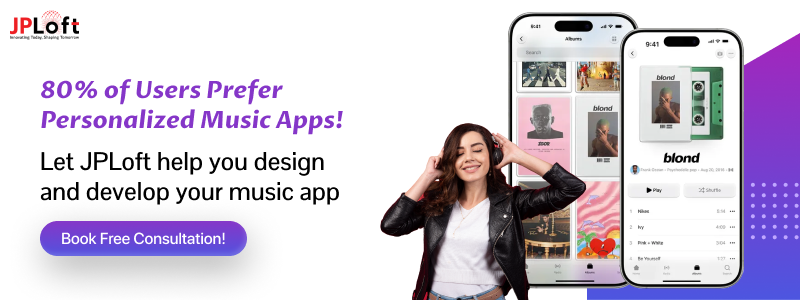
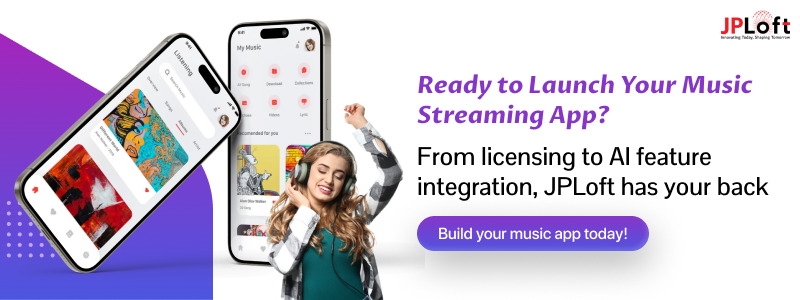

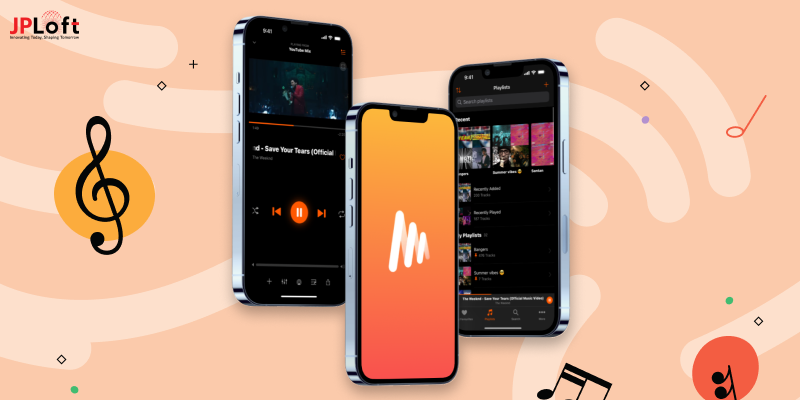
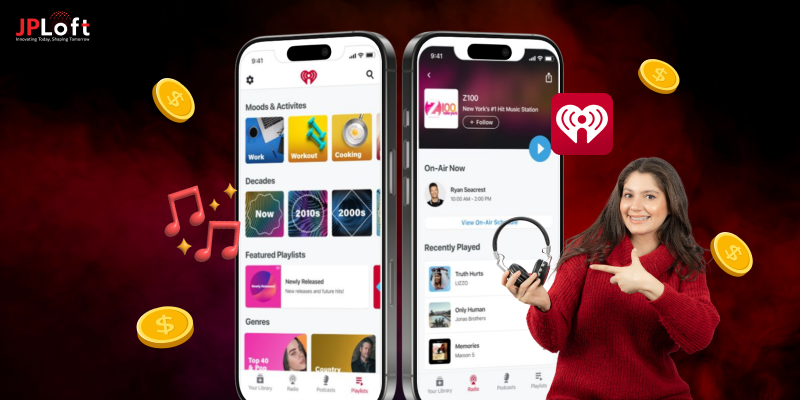
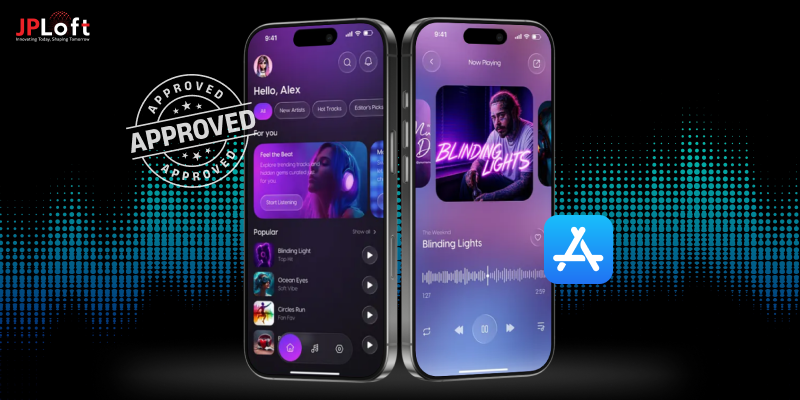


Share this blog